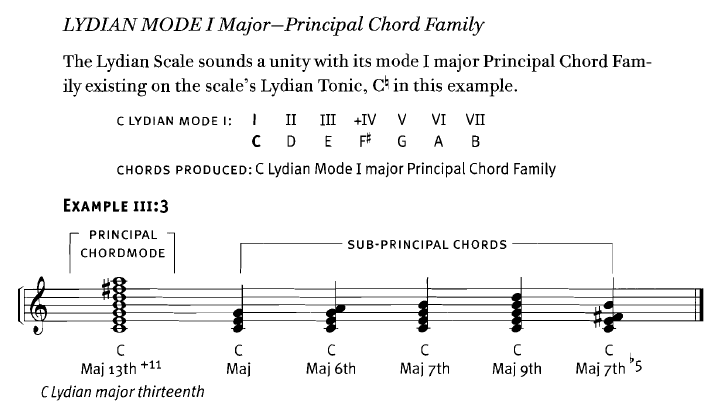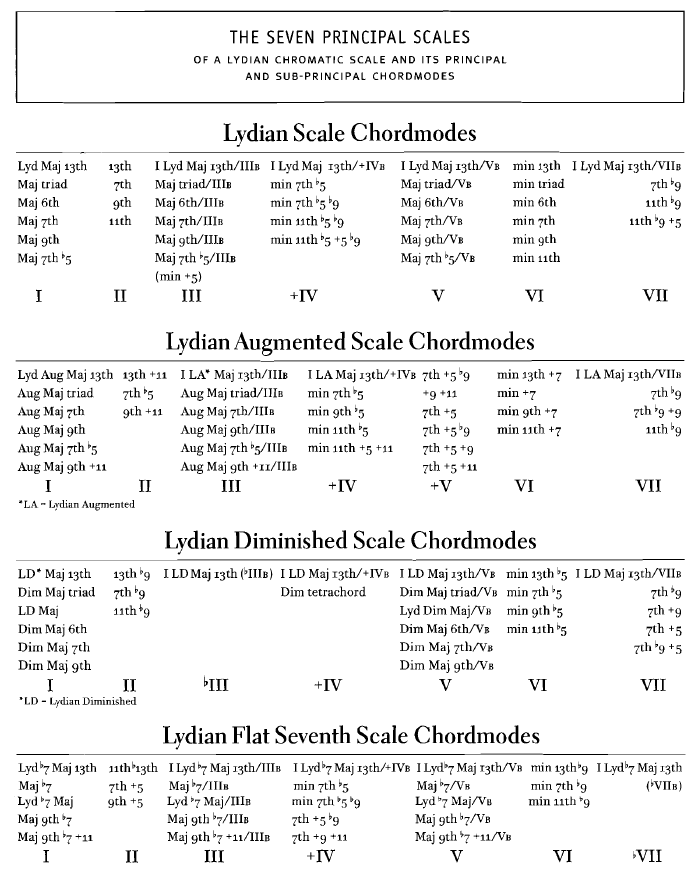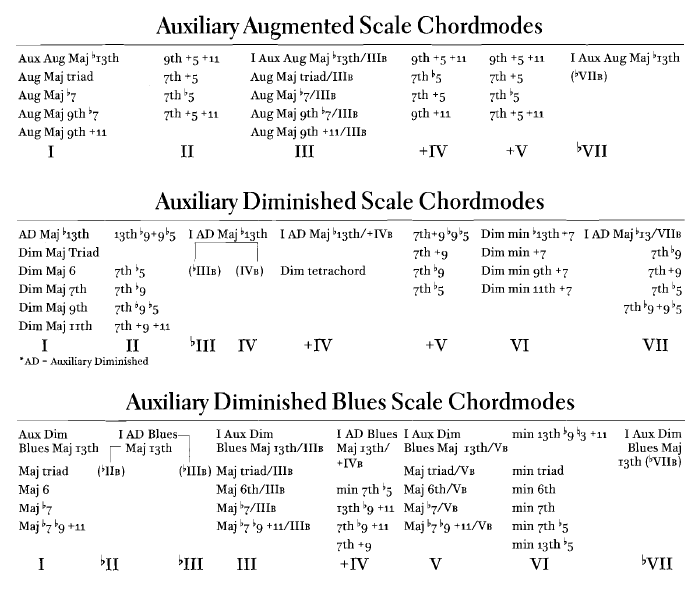Chordmodes, Principle Chordmodes and Principle Chord Families
The Chordmode
In his book “The Lydian Chromatic Concept of Tonal Organization”, George Russell defines the term “chordmode” as a means to better express the sound of a mode. Let’s explore the term “chordmode”.
The starting point is a “parent scale”. Recall that Russell defines 11 scales – the Seven Principle` Scales and Four Horizontal Scales – any of which can be a parent scale in this context. We can take the notes of a parent scale and treat each one as a root note to build a chord from. Additionally, each root note becomes a “modal tonic” with a “mode” being the sequence of notes taken from the parent scale starting from it. Put another way (and perhaps rather obviously), there is a relationship between a chord built from a root note and its associated mode.
It seems that Russell was dissatisfied with the conventional understanding of the relationship between chords and modes. To truly hear the sound of a mode, Russell stated that you need to hear all of the notes in the mode not just a subset of notes used in a conventional chord voicing. He called this concept the “chordmode”; a scale/chord unity.
In other words, the complete sound of a chord is its corresponding mode within its parent scale. Therefore, the broader term CHORDMODE is substituted for what is generally referred to as “the chord”. 1
The Principle Chord and Principal Chordmode
Russell goes on to state that the chordal or homophonic form of a mode is referred to as its “Principal Chord” or “Principal Chordmode”. Typically this is a chord consisting of at least seven notes – all the available notes in a mode played simultaneously.
Each Principal Chord is an arrangement of the tones of a mode into the mode’s most “harmonically evolved” (complete) chordal genre. 2
Simply put, play all the notes of a mode together and you get that mode’s Principal Chordmode.
Each Principal Chordmode produces “Sub-Principal Chords” which are descendant or derivative chords rooted on a modal tonic. Such chords retain the essential harmonic identity of the Principal Chordmode but have fewer extensions (basically, Sub-Principle Chords have fewer notes than the Principle Chordmode).
A Principal Chordmode and its Sub-Principal Chords together can grouped into a “Principal Chord Family”.
Modes of the Lydian Scale
One of the reasons the “Lydian Chromatic Concept of Tonal Organization” seems rather obtuse is that Russell covers familiar ground in unfamiliar ways. For example, Russell defines what he means by “modes” in relation to the the Lydian scale, not the familiar major scale.
You’ll realise that the Lydian scale is traditionally thought of as a mode of the major scale (the fourth mode) but Russell flips that around to treat Lydian as a starting point. In effect the major scale (Ionian mode) becomes a mode of the Lydian scale. Remember that Russell was creating a complete musical theory from scratch, a theory based on the harmonic series which resulted in him placing the Lydian scale at the heart of his theory. It’s therefore only logical that he restate existing concepts in a Lydian-centric way.
So, the basics of Lydian modes – according to Russell – are:
- There are seven modes in the Lydian scale.
- Each mode is rooted off a different degree of the Lydian scale.
- Each mode follows a natural step-wise sequence from the modal tonic (its root note) to its equivalent an octave higher.
That should be familiar to you. It’s the same idea as major scale modes. However, Russell also states that each mode has a Principal Chordmode, as described above.
Principle Chord Families of the Lydian Scale
Armed with the information above we can look at each of the modes of the Lydian scale in turn and define their Principal Chordmode and Sub-Principal Chords. Now, there’s quite a few of these and a short blog post isn’t really the place to go into them all in detail. However, here’s an example of the Lydian Scale Mode I.

Figure 1 – Lydian Mode I Major – Principle Chord Family 3
So, there’s the Principle Chordmode on the left and all the acceptable Sub-Principle Chordmodes on the right.
In the book there is a chart that lists the Principle Chord Families for each of the Seven Principle Scales and their modes. Here it is:


Figure 2 – Chart A from The Lydian Chromatic Concept of Tonal Organization 4
If you look at the first section, Lydian Scale Chordmodes, it shows the various chords possible for each mode (I to VII) of the Lydian scale. The first line shows the Principle Chordmode (e.g. Lyd Maj 13 for mode I) and under that the Sub-Principle Chordmodes.
Back to Part 1 (index to posts in the series)
Reference
- Russel, G (2001). The Lydian Chromatic Concept of Tonal Organization, 4th Edition, p.21
- Russel, G (2001). The Lydian Chromatic Concept of Tonal Organization, 4th Edition, p.22
- Russel, G (2001). The Lydian Chromatic Concept of Tonal Organization, 4th Edition, p.23
- Russel, G (2001). The Lydian Chromatic Concept of Tonal Organization, 4th Edition, inside cover

Hello! I really thank you for posting all these info, but I still don’t clearly understand how it must be put into practice and how can one play over normal chord progressions using this concept. Could you explain that when you have the time please??